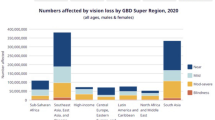Abstract
Video magnifiers provide people with low vision a means to maintain a degree of independence by helping them to read and write. The design of these machines has remained essentially unchanged for 20 years, despite advances in computer technology. Designing reading aids with increased technological complexity and added functionality requires an understanding of the specific needs of this user group. The research described in this paper determines aspects that need to be considered and analyses comparative performance on a simple reading task between an existing closed circuit television video magnifier (CCTV) and a more complex low-vision reading aid, myReader, under development in New Zealand. Performance, comfort ratings and preference results suggest that myReader provides a more pleasurable reading experience than traditional CCTVs. Common error analysis highlights aspects of myReader that should be altered to improve the experience by eliminating actions that cause errors and resulting negative emotions.








Similar content being viewed by others
References
Lund R, Watson GR (1997) The CCTV book: habilitation and rehabilitation with CCTV systems. Synsforum ans Frolund, Oslo, Norway
Stephens EC, Carswell CM et al (2000) The use of older adults on preference panels: evidence from Kentucky interface preference inventory. Int J Cogn Ergon 4(3):179–190
Department of Trade and Industry (2000) A study of the difficulties that disabled people have when using everyday consumer products. URN 00/1070. Department of Trade and Industry, London
Rosen LD, Weil MM (1995) Adult and teenage use of consumer, business, and entertainment technology: potholes on the information superhighway? J Consum Aff 29(1):55–84
Anderson JR (2000) Cognitive psychology and its implications. Worth, New York
D’Amato R, Synder J (2000) Macular degeneration. Oxford University Press, Oxford
Royal New Zealand Foundation for the Blind (RNZFB) (2001) Eye conditions: macular degeneration. At: http://www.rnzfb.org.nz/Education/amd.php
Flax ME, Golembiewski DJ, McCaulley BL (1993) Coping with low vision. Singular, San Diego
Cassel GH, Billig MD, Randall HG (1998) The eye book: a complete guide to eye disorders and health. John Hopkins University Press, Baltimore
Harpster J, Frievalds A, Shuman G, Leibowitz H (1989) Visual performance on CRT screens and hard-copy displays. Hum Factors 31:247–257
Sanders MS, McCormick EJ (1993) Human factors in engineering and design. McGraw-Hill, New York
Jordan P (2000) Designing pleasurable products. Taylor and Francis, London
Tractinsky N, Katz AS, Ikar D (2000) What is beautiful is usable. Interact Comput 13:127–145
Jordan PW (1998) An introduction to usability. Taylor and Francis, London
Pheasant ST (1996) Bodyspace: anthropometry, ergonomics and design. Taylor and Francis, London
Harland S, Legge GE, Luebeker A (1998) Psychophysics of reading. XVII. Low vision performance with four types of electronically magnified text. Optom Vis Sci 75(3):183–190
Ransom A (1982) Swallows and Amazons. Chaucer, Bungay, Suffolk, UK
Acknowledgements
This research was funded by a Technology in Industry Fellowship (TIF) grant from the Foundation for Science Research and Technology in New Zealand, in association with Christchurch based Pulse Data Limited, as an HIT Lab NZ project. I would like to sincerely thank all the people who invited me into their homes and participated in the study.
Author information
Authors and Affiliations
Corresponding author
Rights and permissions
About this article
Cite this article
Harrison, C.M. Low-vision reading aids: reading as a pleasurable experience. Pers Ubiquit Comput 8, 213–220 (2004). https://doi.org/10.1007/s00779-004-0280-0
Received:
Accepted:
Published:
Issue Date:
DOI: https://doi.org/10.1007/s00779-004-0280-0




